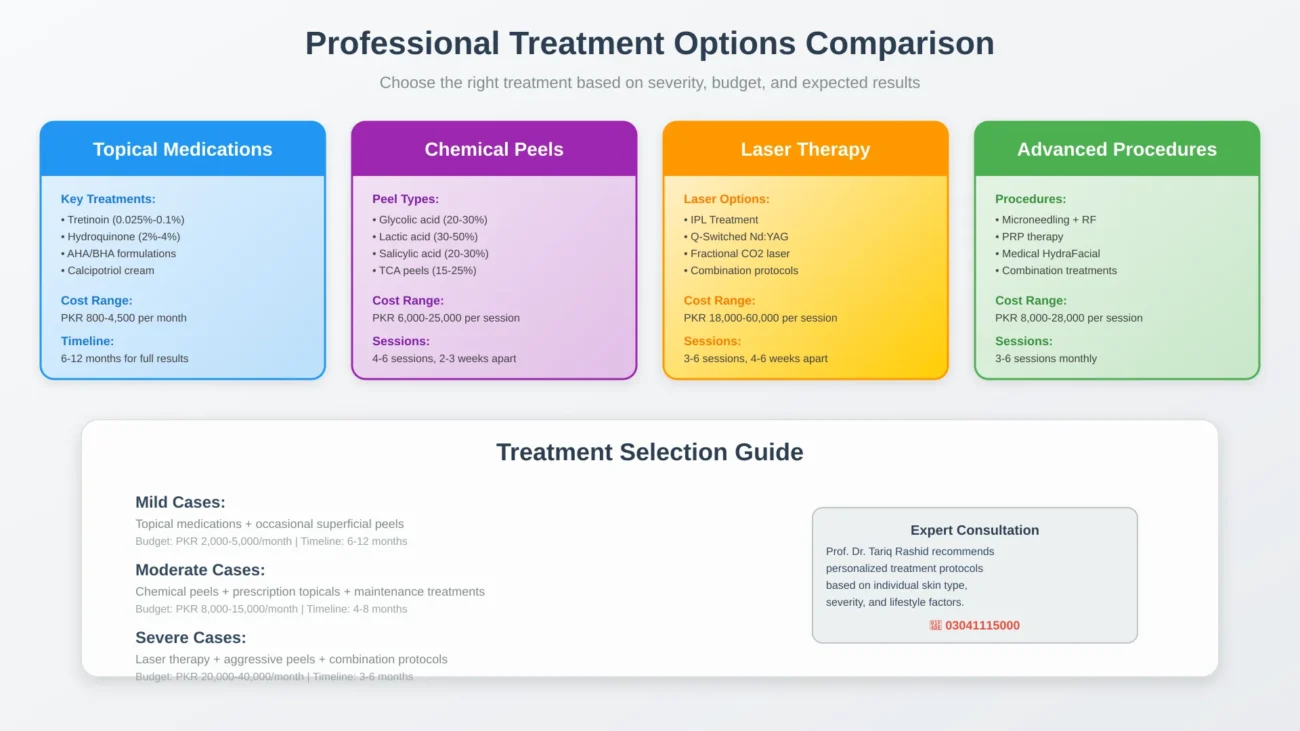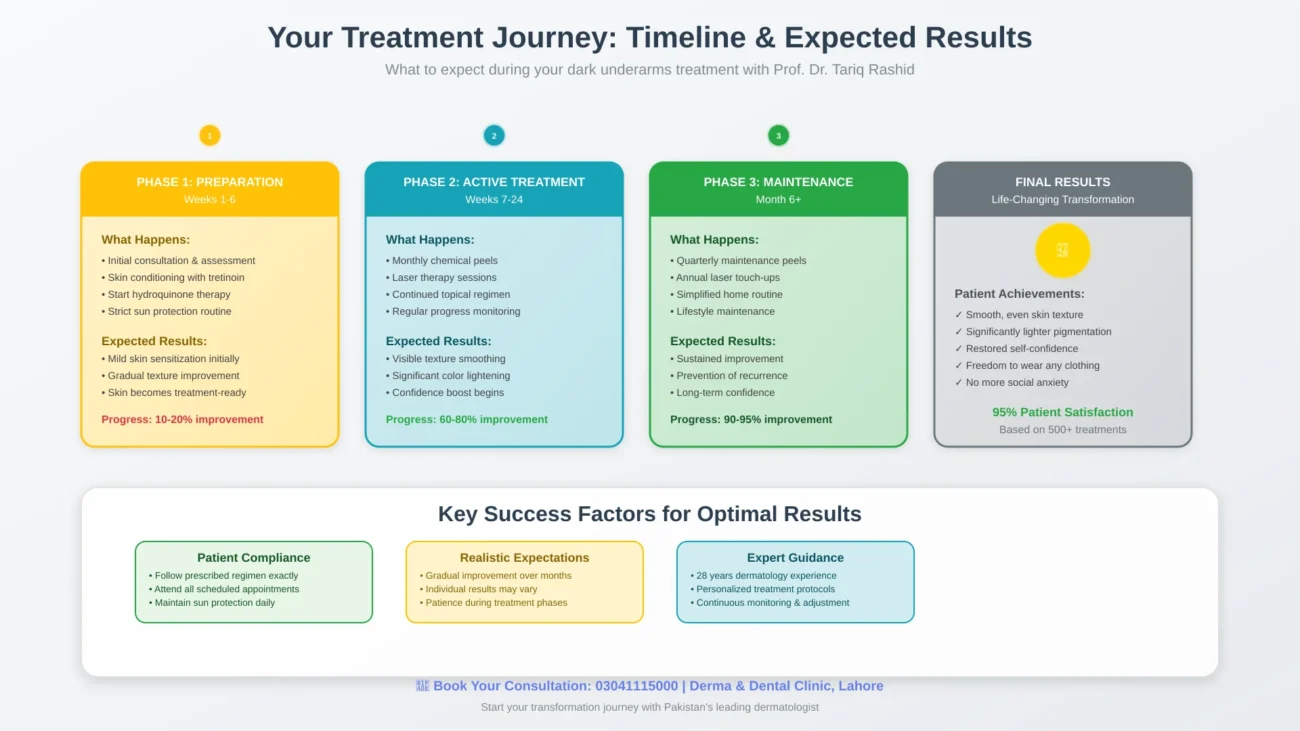Professional Treatments for Dark Underarms in Pakistan: Complete Cost & Options Guide
Professional treatments for acanthosis nigricans offer faster results than home remedies alone. With advanced dermatological procedures now available across Pakistan’s major cities, patients have access to medical-grade treatments that can significantly improve both skin texture and pigmentation.
This comprehensive guide covers all professional treatment options available in Pakistan, including detailed costs, expected results, and what to expect during each procedure. Whether you’re considering chemical peels, laser therapy, or prescription medications, this guide helps you make informed decisions about your treatment journey.
Prescription Medications: Medical-Grade Topical Treatments
Tretinoin (Retinoic Acid) Therapy:
Tretinoin remains the gold standard prescription treatment for acanthosis nigricans, working by normalizing skin cell turnover and reducing hyperkeratosis.
How tretinoin works:
- Increases cell turnover rate, removing thick skin layers
- Normalizes keratinocyte differentiation
- Reduces skin thickness over time
- Gradually improves texture and appearance
Prescription formulations available in Pakistan:
- Tretinoin 0.025% cream: Starting strength for sensitive skin
- Tretinoin 0.05% gel: Moderate strength for oily skin types
- Tretinoin 0.1% cream: Maximum strength for resistant cases
- Combination formulations: With hydroquinone or corticosteroids
Treatment protocol:
- Start with 0.025% concentration 2-3 times weekly
- Gradually increase frequency as tolerance develops
- Apply to affected areas in evening only
- Always use sunscreen during daytime
- Expect initial mild irritation and peeling
Timeline and expectations:
- Initial improvement: 6-8 weeks
- Significant texture changes: 3-4 months
- Maximum benefit: 6-12 months of consistent use
Cost in Pakistan:
- Generic tretinoin: PKR 800-1,500 per tube
- Brand formulations: PKR 1,800-3,500 per tube
- Monthly cost: PKR 1,000-2,000
Hydroquinone-Based Depigmenting Agents:
Hydroquinone effectively lightens hyperpigmentation by inhibiting melanin production, making it valuable for the pigmentary component of acanthosis nigricans.
Hydroquinone concentrations:
- 2% over-the-counter formulations: Mild lightening effect
- 4% prescription strength: Standard medical treatment
- 6-8% dermatologist compounded: For resistant pigmentation
Mechanism of action:
- Inhibits tyrosinase enzyme in melanin synthesis
- Reduces melanin production in affected areas
- Gradually lightens existing pigmentation
- Works best in combination with other treatments
Treatment protocol:
- Apply twice daily to affected areas only
- Use for maximum 6-month cycles with breaks
- Must use broad-spectrum sunscreen daily
- Combine with tretinoin for enhanced efficacy
Combination formulations available:
- Hydroquinone + tretinoin + mild corticosteroid (Kligman’s formula)
- Hydroquinone + glycolic acid combinations
- Hydroquinone + kojic acid formulations
Cost considerations:
- 2% hydroquinone: PKR 600-1,200
- 4% prescription: PKR 1,500-2,800
- Compounded formulations: PKR 2,500-4,500
Alpha Hydroxy Acids (AHAs) and Beta Hydroxy Acids (BHAs)
Medical-grade AHA and BHA formulations provide controlled exfoliation and texture improvement.
Glycolic acid formulations:
- 10-20% daily use formulations
- 30-50% professional peeling solutions
- Improves skin texture and mild pigmentation
- Enhances penetration of other treatments
Lactic acid benefits:
- Gentler than glycolic acid
- Better for sensitive skin types
- Provides both exfoliation and hydration
- Less likely to cause irritation
Salicylic acid (BHA) advantages:
- Oil-soluble for better penetration
- Anti-inflammatory properties
- Suitable for acne-prone skin
- Helps with both texture and pigmentation
Prescription AHA/BHA costs:
- Medical-grade formulations: PKR 2,000-4,500
- Professional peeling solutions: PKR 3,500-6,000
- Combination products: PKR 2,500-5,500
Calcipotriol (Vitamin D Analog):
Calcipotriol normalizes skin cell growth and can be particularly effective for the hyperkeratotic component of acanthosis nigricans.
Mechanism and benefits:
- Regulates keratinocyte proliferation
- Reduces skin thickness
- Improves texture without causing irritation
- Can be used long-term safely
Formulations available:
- 0.005% ointment or cream
- Combination with betamethasone
- Suitable for sensitive areas

Chemical Peels: Professional Exfoliation Treatments
Superficial Chemical Peels
Superficial peels target the epidermis, providing gentle improvement in both texture and pigmentation with minimal downtime.
Glycolic acid peels (20-30%):
- Most popular peel for acanthosis nigricans
- Removes surface dead skin cells
- Stimulates cell turnover
- Minimal downtime with mild peeling
Lactic acid peels (30-50%):
- Gentler alternative to glycolic acid
- Better for darker skin tones
- Provides hydration while exfoliating
- Lower risk of post-inflammatory hyperpigmentation
Salicylic acid peels (20-30%):
- Excellent for oil-prone skin
- Anti-inflammatory benefits
- Penetrates into pores
- Suitable for concurrent acne
Treatment protocol:
- Series of 4-6 peels spaced 2-3 weeks apart
- Gradual concentration increase with each session
- Pre-peel preparation with topical agents
- Post-peel care with moisturizers and sunscreen
Expected results:
- Immediate: Mild redness and tightness
- 3-7 days: Superficial peeling
- 2-4 weeks: Improved texture and tone
- After series: Significant texture improvement
Medium-Depth Chemical Peels:
Medium-depth peels penetrate into the dermis, providing more dramatic results for resistant cases.
Trichloroacetic acid (TCA) peels (15-25%):
- More aggressive treatment option
- Reaches deeper skin layers
- Significant improvement in texture and pigmentation
- Requires 7-10 days recovery time
Jessner’s peel combinations:
- Combination of salicylic acid, lactic acid, and resorcinol
- Controlled depth penetration
- Good for uneven skin tones
- Suitable for acanthosis nigricans with concurrent issues
Treatment considerations:
- Requires experienced dermatologist
- Pre-treatment conditioning essential
- Longer recovery period
- Risk of temporary hyperpigmentation
Post-Peel Care Protocol
Immediate post-treatment (24-48 hours):
- Cool compresses for comfort
- Gentle cleansing with mild soap
- Application of prescribed healing ointments
- Strict sun avoidance
Peeling phase (3-7 days):
- Moisturize frequently with recommended products
- Avoid picking or pulling peeling skin
- Continue sun protection
- Use prescribed post-peel treatments
Recovery phase (1-2 weeks):
- Gradual return to normal skincare routine
- Continue daily sunscreen application
- Monitor for any complications
- Follow-up appointment as scheduled
Laser Therapy Options
Intense Pulsed Light (IPL) Treatment:
How IPL works for acanthosis nigricans:
- Broad-spectrum light targets melanin
- Breaks down pigment deposits
- Stimulates collagen production
- Improves overall skin texture
Treatment protocol:
- Series of 4-6 sessions spaced 3-4 weeks apart
- Each session lasts 20-30 minutes
- Mild discomfort during treatment
- No significant downtime required
Suitable candidates:
- Light to medium skin tones (Fitzpatrick I-IV)
- Primarily pigmentary concerns
- No active skin infections
- Realistic expectations about results
Q-Switched Nd:YAG Laser
This laser specifically targets melanin deposits while being safe for darker skin tones common in Pakistan.
Advantages for Pakistani patients:
- Safe for darker skin types (Fitzpatrick IV-VI)
- Minimal risk of hypopigmentation
- Effective for stubborn pigmentation
- Quick treatment sessions
Treatment process:
- 3-5 sessions typically required
- 4-6 week intervals between treatments
- Mild swelling and darkening initially
- Gradual lightening over 2-4 weeks post-treatment
Expected costs: PKR 20,000-35,000 per session
Fractional CO2 Laser Resurfacing:
Benefits for acanthosis nigricans:
- Addresses both texture and pigmentation
- Stimulates significant collagen remodeling
- Most dramatic results available
- Long-lasting improvement
Treatment considerations:
- Requires local anesthesia
- Significant recovery time (1-2 weeks)
- Risk of temporary hyperpigmentation
- Best for severe, resistant cases
Laser Treatment Selection Criteria:
Factors influencing laser choice:
- Skin tone and Fitzpatrick type
- Severity of condition
- Patient downtime tolerance
- Budget considerations
- Concurrent skin conditions
Pre-laser preparation:
- Skin conditioning with tretinoin
- Sun protection for 4-6 weeks
- Discontinuation of certain medications
- Realistic expectation setting
Advanced Cosmetic Procedures
Microneedling and Radiofrequency:
Microneedling benefits:
- Stimulates natural collagen production
- Improves product penetration
- Safe for all skin types
- Minimal downtime required
Treatment protocol:
- Series of 3-6 sessions monthly
- Combination with serums or PRP
- Progressive needle depth increase
- Post-treatment care essential
Radiofrequency skin tightening:
- Addresses skin laxity component
- Stimulates deep dermal remodeling
- Comfortable treatment experience
- Gradual improvement over months
Platelet-Rich Plasma (PRP) Therapy:
PRP treatment utilizes patient’s own platelets to stimulate skin regeneration and healing.
PRP benefits for acanthosis nigricans:
- Natural growth factor delivery
- Enhances other treatment results
- Improves overall skin quality
- Safe with minimal side effects
Treatment process:
- Blood draw and platelet concentration
- Topical numbing for comfort
- Injection or microneedling application
- Series of 3-4 treatments recommended
Medical-Grade HydraFacial:
Following are benefits of HydraFacial:
- Deep cleansing and exfoliation
- Immediate glow and texture improvement
- No downtime required
- Can be combined with other treatments
Treatment steps:
- Cleansing and exfoliation
- Acid peel application
- Extraction and hydration
- Antioxidant and peptide infusion
Combination Treatment Protocols
Sequential Treatment Approach:
Most effective results come from combining multiple treatment modalities in a strategic sequence.
Phase 1: Preparation (4-6 weeks):
- Topical tretinoin and hydroquinone
- Gentle home exfoliation
- Strict sun protection
- Skin barrier repair
Phase 2: Active Treatment (3-6 months):
- Chemical peels or laser sessions
- Continued topical medications
- Professional treatments every 3-4 weeks
- Regular monitoring and adjustments
Phase 3: Maintenance (Ongoing):
- Monthly maintenance peels
- Continued topical therapy
- Annual laser touch-ups
- Long-term sun protection
Customized Treatment Plans:
Our Dermatologists including Dr. Eram Razzaq & Prof. Dr. Tariq Rasheed develop individualized treatment protocols based on:
- Severity of acanthosis nigricans
- Patient skin type and sensitivity
- Budget and time constraints
- Previous treatment responses
- Concurrent medical conditions
Mild cases protocol:
- Topical tretinoin + hydroquinone
- Quarterly superficial peels
- Good home skincare routine
- Regular dermatology follow-up
Moderate cases approach:
- Combination topical therapy
- Monthly chemical peels
- Semi-annual laser treatments
- Lifestyle modification support
Severe cases management:
- Aggressive topical regimen
- Combination chemical peels
- Multiple laser modalities
- Possible systemic treatments

Look no furhter for expert dermatologist guidance; Contact: 03041115000 | Derma & Dental Clinic, Lahore

